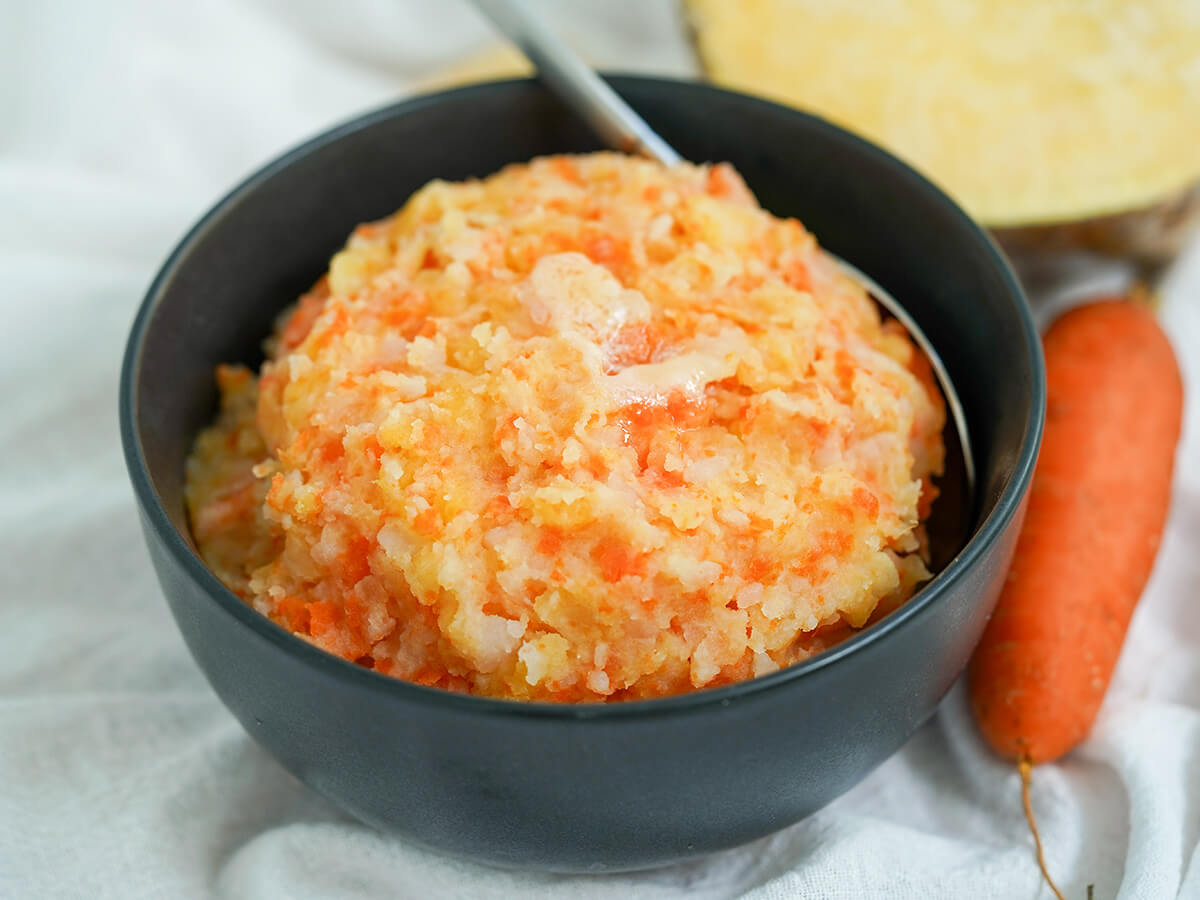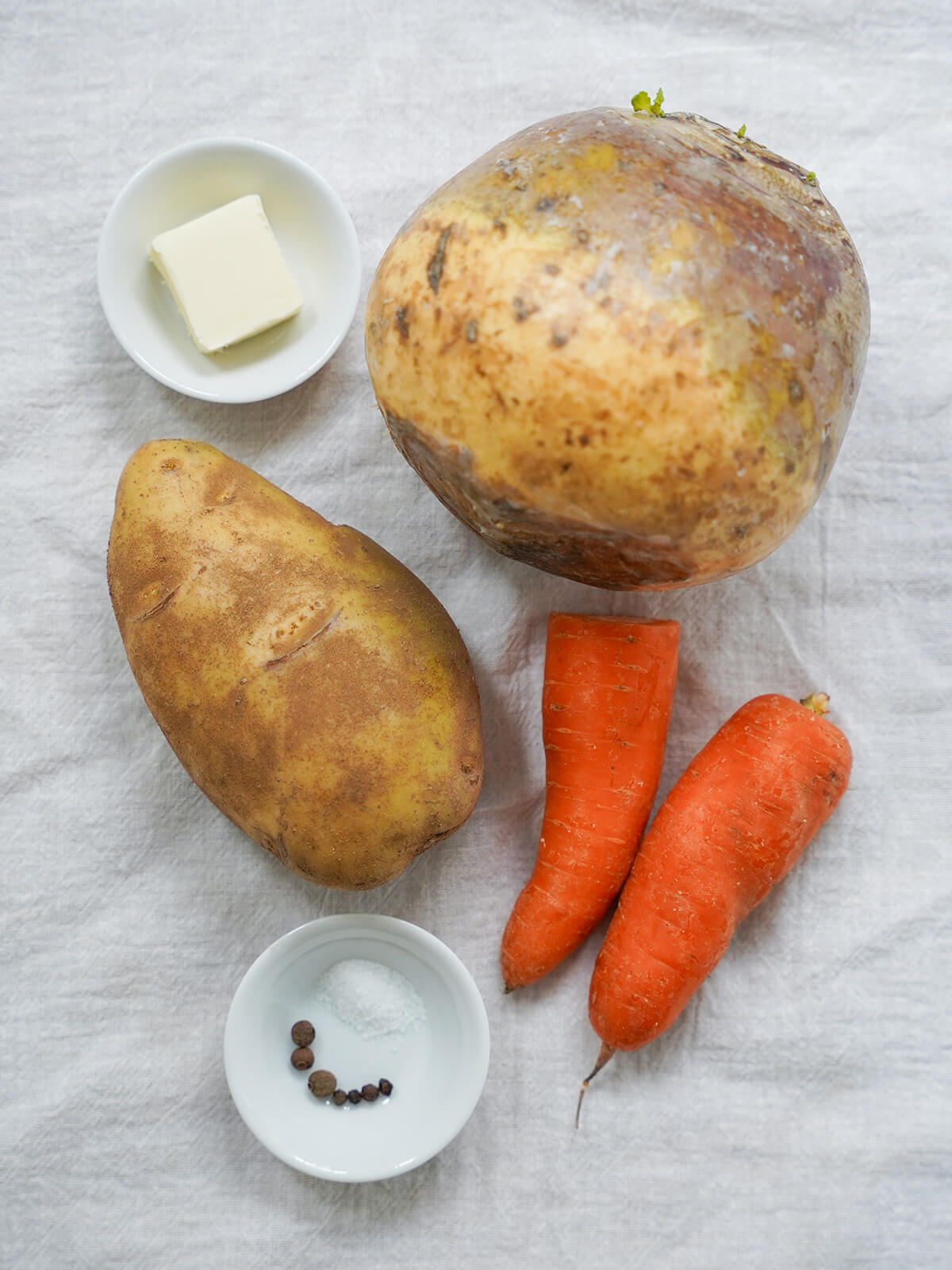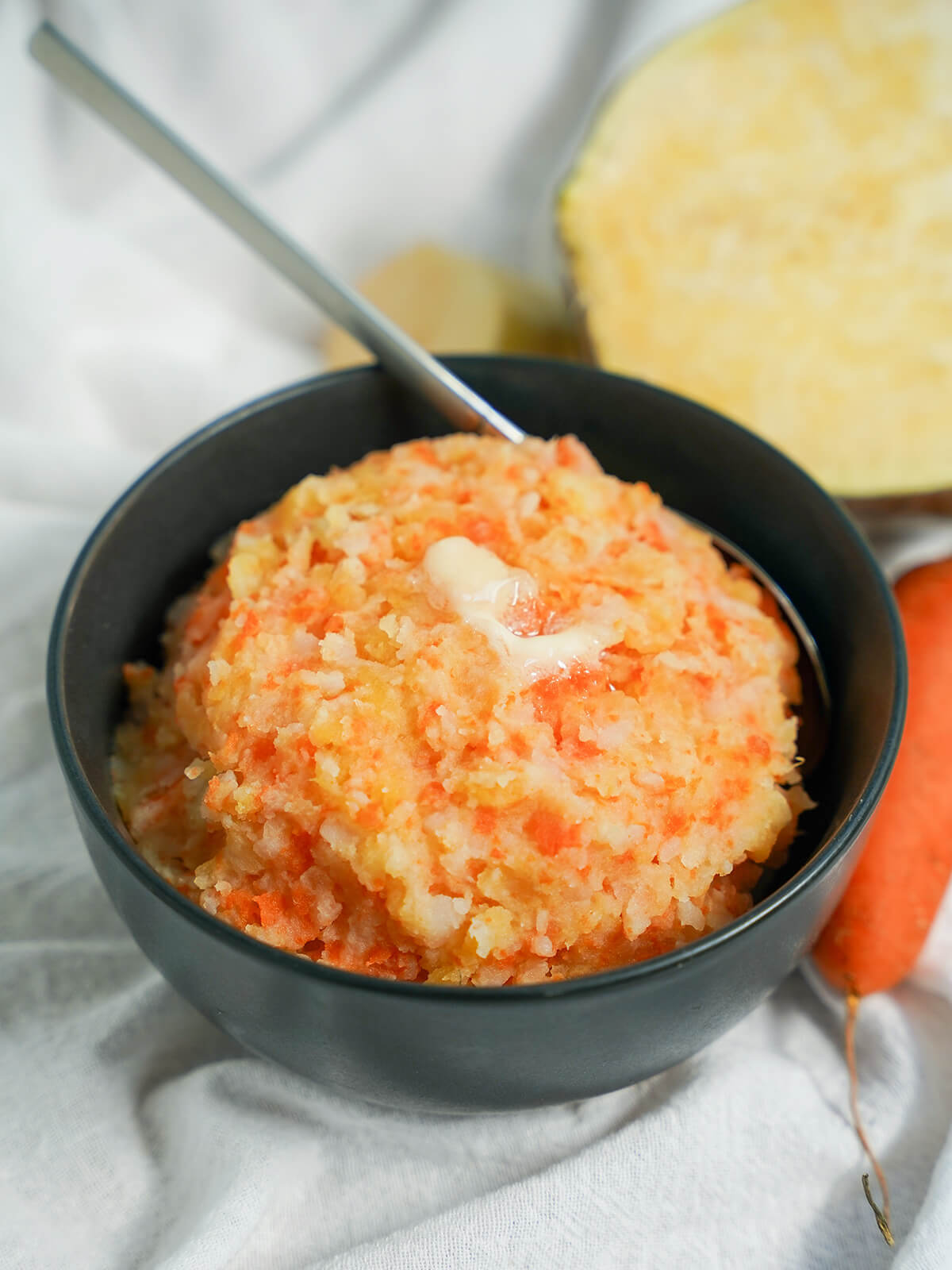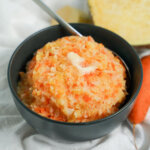This Swedish root vegetable mash, rotmos, has all the comfort factor of mashed potato but with more depth of flavor, thanks to the other vegetables in the mix. It's easy to make and pairs well with many a main from ham to stews and more.

This post may contain affiliate links, where we earn from qualifying purchases. See more details in the policy page.
For many parts of Northern Europe, potato is the go-to side vegetable. It's easy to understand why, since it grows well in the cooler climate and it's versatile in how you use it. Mashed, fried, boiled or baked, it's a relatively blank canvas, and economical too.
Before potatoes arrived in Europe form the Americas, other roots like turnips, carrots, parsnips and rutabaga were popular. Carrots have held their popularity, but the others maybe less so. Though Swedish and Scottish cooking may be an exception. Mashed rutabaga is a traditional side to haggis in Scotland and popular in Sweden, too. This mixed root mash is another traditional Swedish dish that puts those roots to good use.

What is rotmos?
"Rotmos" literally translates as "root (vegetable) mash" and is classic 'husmanskost', best translated as comfort food. It's most classically paired with Fläsklägg, boiled ham hock, but you'll also find it served with sausage or roast pork.
It's incredibly simple, as it literally boiled vegetables, mashed with some butter, and little more. You generally season with a little salt and pepper and may use allspice in as the vegetables cook and/or use stock rather than water as cooking liquid for a little added flavor.
It's super simple yet feels a little more interesting than any individual mash since there are more flavors in the mix. Plus it's colorful, too, so a lovely addition to a festive table and more.

What vegetables go in root vegetable mash?
This is a dish that has some flexibility in exactly what you put in it, so it's great to adapt to taste, what you have and prefer. That said, a pretty classic combination is what I have used here:
- Potato,
- Rutabaga,
- Carrot.
This trio gives a lovely mix of flavors and color so it's both bright and tasty. The exact variety of potato is not too important, though you might want to avoid a waxy potato or one that gets gummy. I used russet as they make a nice fluffy mash.
Another relatively common addition that I am always in favor of is parsnips, which add another little sweetness and burst of flavor. You could also add in things like celeriac (celery root) or kohlrabi, or less traditional, but also tasty, sweet potato.

One note on rutabaga is it goes by a few names. Rutabaga is apparently a hybrid of cabbage and turnip and is believed to have originated in Scandinavia, Finland or Russia. A Swiss botanist, Gaspard Bauhin, first recorded it in 1620 having found it growing wild in Sweden (ref: Wikipedia). This may be part of why it is called Swede in England, and has Sweden in the name in some other languages.
Tips for making this
This is so simple there are very few tips, but a couple small things to note:
- Peel and dice in medium-sized chunks - skins can be tasty, but without them, it's a smoother texture.
- Not all vegetables take the same time to cook, so add them to the water accordingly. Rutabaga and carrots take longer than potato, so give them more time to cook.
I've given a suggested amount of butter which is pretty typical, but feel free to add more to give a slightly richer, creamier mash if you prefer. And don't forget to add some salt and pepper - you don't need too much, but to your taste.

Serving ideas
As mentioned above this is a classic side to Fläsklägg, boiled ham hock, but you might also commonly serve it with sausage or roast pork. It's also great with a much broader range of mains as well.
You could try it with other roast meats such as chicken, turkey or beef (think festive meals!). Mash is also perfect for mopping up sauces, so it's great with stews or dishes with for example gravy or a red wine sauce. We've had it with braised lamb which worked well, too.
This Swedish root vegetable mash, rotmos, might be a humble, simple side dish, but it's also a lovely mix of colors and flavors. It's pure comfort food and versatile in what it goes with. Easy to make and to enjoy, so be sure to do so soon.

Try these other tasty vegetable sides:
- Vichy carrots (French glazed carrots - one of the few ways one of my kids will happily eat carrots!)
- Asparagus mimosa (a lovely, colorful dish with asparagus topped with fluffy egg and a bright vinaigrette)
- German red cabbage with apples (a big favorite in our house, with lovely mild warm spice flavors)
- Plus get more side dish recipes and Nordic recipes in the archives.
Swedish root vegetable mash, rotmos
Ingredients
- ½ lb potato suggest floury variety, weight after peeling
- ½ lb rutabaga swede, weight after peeling
- ¼ lb carrots weight after peeling
- 3 peppercorns
- 3 allspice whole
- ¼ teaspoon salt
- 1 tablespoon unsalted butter
- a little black pepper and salt to taste
Instructions
- Peel the potatoes, rutabaga/swede and carrot, removing all of the outer layer of skin and any areas under the skin that seem a bit green or otherwise not as good. Dice into medium-sized cubes around 1 ½in/4 cm.
- Place the diced rutabaga and carrots in a pot/pan along with the peppercorns, allspice and salt. Fill with cold water so the vegetables are covered and there is a bit extra (as you will add the potato a bit later). Cover the pot/pan and place on a medium-high heat to bring it to a boil.
- Once boiling, reduce the heat to keep at a steady boil and cook for around 10 - 15 minutes until the rutabaga and carrot are just tender to a knifepoint (I'd recommend checking now and then after 10 minutes as cooking time can vary).
- Add the potato and cook for another 10 minutes until the potato is tender. Remove from the heat and drain all the water from the pot and remove the peppercorns and allspice. Leave the vegetables in the pot.
- Add the butter to the cooked, hot vegetables and mash them together so that the butter melts in as you mash. You may still have the odd lumps of rutabaga and carrot, but the potato should be relatively smooth. Try not to over-mix in case the potato becomes gummy. Season with a little salt and pepper, to taste. Serve warm.
Notes
Nutrition
See some of my favorite cooking tools and ingredients in the Caroline's Cooking Amazon store.
Remember to pin for later!




Leave a Reply